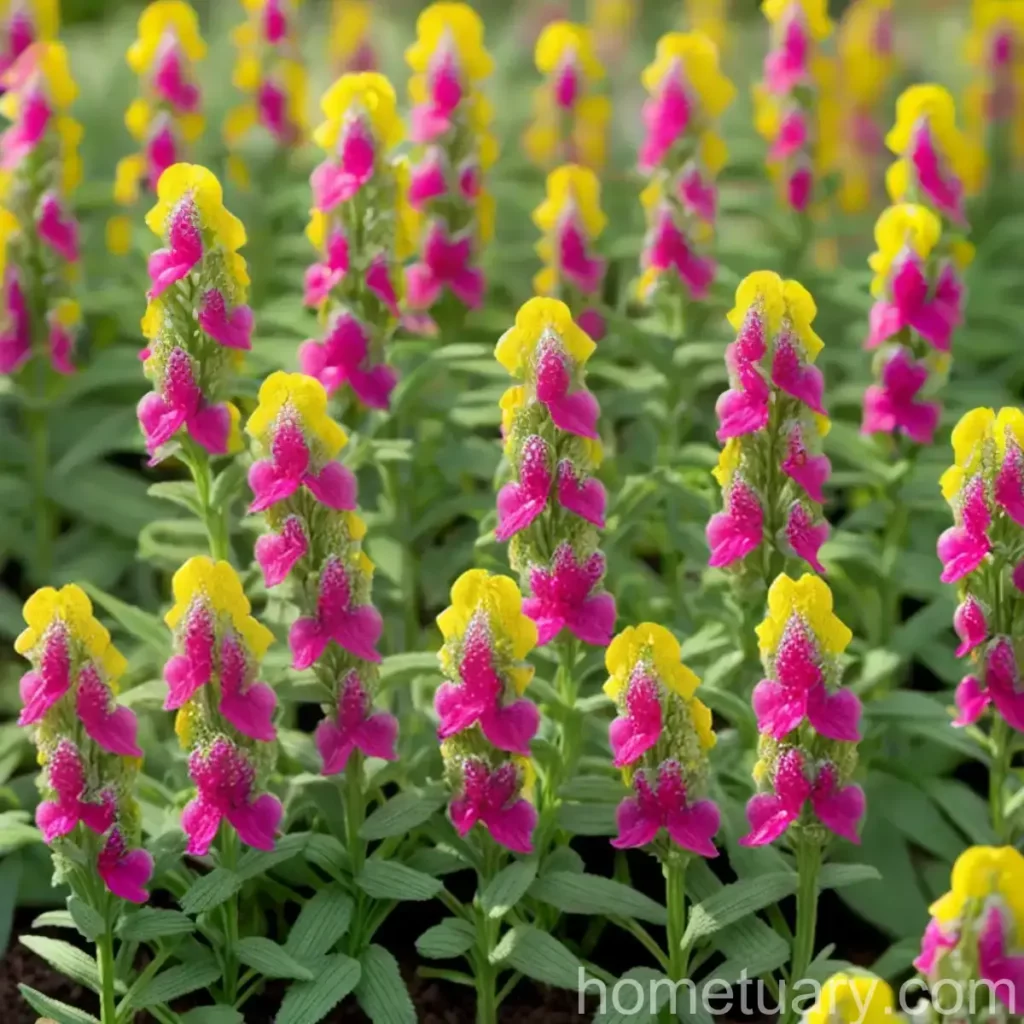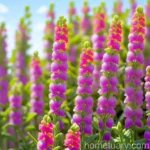Snapdragon, Antirrhinum ‘Dulcinea’s Heart’: An in-depth Plant Profile
Snapdragon (Antirrhinum ‘Dulcinea’s Heart’) is a captivating and versatile plant that has gained popularity among gardeners and plant enthusiasts. In this comprehensive plant profile, we will delve into the intricate details of this beautiful plant, including its culture, uses, maintenance, and much more.
What is Snapdragon (Antirrhinum ‘Dulcinea’s Heart’)?
Plant Classification
- Kingdom: Plantae
- Order: Lamiales
- Family: Plantaginaceae
- Genus: Antirrhinum
- Species: Antirrhinum majus
- Cultivar: ‘Dulcinea’s Heart’
Snapdragon, known by its scientific name Antirrhinum, is a genus of plants belonging to the family Plantaginaceae. ‘Dulcinea’s Heart’ is a specific cultivar within the Antirrhinum majus species, distinguished by its unique characteristics that set it apart from other varieties.
Description
Snapdragon ‘Dulcinea’s Heart’ is renowned for its ornamental value, characterized by stunning, heart-shaped blooms that impart an aesthetic appeal to any garden or landscape. The name “snapdragon” is derived from the flower’s resemblance to a dragon’s face, which opens and closes its mouth when squeezed from the sides. The plant is known for its charming, bell-shaped flowers that come in an array of hues, adding a vibrant splash of color to outdoor spaces.
Key Takeaways – Snapdragon (Antirrhinum ‘Dulcinea’s Heart’)
Before we embark on a detailed exploration of the Snapdragon plant, let’s outline some of the key takeaways associated with this mesmerizing species.
- Snapdragon ‘Dulcinea’s Heart’ is a captivating cultivar within the Antirrhinum majus species, distinguished by its heart-shaped blooms.
- The plant is known for its bell-shaped flowers that come in a variety of vibrant hues, adding an aesthetic appeal to gardens and landscapes.
- Snapdragon ‘Dulcinea’s Heart’ is versatile and can be used for various landscaping and gardening purposes, contributing to its popularity among plant enthusiasts.
Now, let’s delve into various aspects of Snapdragon ‘Dulcinea’s Heart’ to gain a comprehensive understanding of its culture, uses, maintenance, and more.
Culture
The culture of Snapdragon ‘Dulcinea’s Heart’ encompasses the plant’s overall growth habits, including its water, sunlight, fertilizer, soil, and pruning requirements.
Water
Snapdragon ‘Dulcinea’s Heart’ thrives in well-draining soil and requires regular watering to maintain adequate soil moisture. It is crucial to avoid overwatering or waterlogging, as this can lead to root rot and other water-related issues. However, the plant should not be allowed to dry out completely between watering sessions.
Sunlight
In terms of sunlight requirements, Snapdragon ‘Dulcinea’s Heart’ flourishes in full sun to partial shade conditions. It typically performs best when exposed to at least 6-8 hours of sunlight per day, ensuring optimal growth and prolific blooming.
Fertilizer
To promote healthy growth and prolific flowering, it is advisable to fertilize Snapdragon ‘Dulcinea’s Heart’ with a balanced, all-purpose fertilizer. Regular feeding during the growing season can help enhance the plant’s vigor and overall performance.
Soil
Well-drained, fertile soil is essential for the successful cultivation of Snapdragon ‘Dulcinea’s Heart.’ The soil should be enriched with organic matter and have good drainage properties to prevent waterlogging, which can be detrimental to the plant’s health.
Pruning
Pruning is an integral part of Snapdragon ‘Dulcinea’s Heart’ maintenance. Regular deadheading, which involves the removal of spent blooms, can encourage continuous flowering and prevent the plant from expending energy on seed production.
Uses
Ornamental Value
One of the primary uses of Snapdragon ‘Dulcinea’s Heart’ is its ornamental value. The plant’s exquisite, heart-shaped blooms make it a popular choice for adding visual interest to flower beds, borders, and containers. Its vibrant flowers often serve as focal points in garden landscapes and are cherished for their aesthetic appeal.
Cut Flowers
Snapdragon ‘Dulcinea’s Heart’ is often utilized in floral arrangements and bouquets, thanks to its long-lasting flowers and striking appearance. The plant’s unique blooms make it a sought-after choice for incorporating into floral designs and indoor flower displays.
Pollinator Attraction
The nectar-rich flowers of Snapdragon ‘Dulcinea’s Heart’ can attract pollinators such as bees, butterflies, and hummingbirds, contributing to the overall biodiversity and ecological balance within the garden or landscape.
Propagation
Seed Propagation
Snapdragon ‘Dulcinea’s Heart’ can be propagated from seeds, allowing for the expansion of plant populations. When propagating from seeds, it is essential to provide the optimal germination conditions, including adequate moisture, warmth, and light to support the seedlings’ development.
Division
In some cases, Snapdragon ‘Dulcinea’s Heart’ can also be propagated through division, which involves separating clumps of the plant to create new individuals. This method of propagation can help rejuvenate older plants and increase the overall plant stock.
Container Popularity
Snapdragon ‘Dulcinea’s Heart’ is well-suited for container cultivation, making it a popular choice for balcony gardens, patios, and other confined spaces. Its compact growth habits and striking blooms make it an excellent container plant, adding a touch of elegance to outdoor living areas.
Common Diseases
While Snapdragon ‘Dulcinea’s Heart’ is generally resilient, it may be susceptible to certain diseases that can impact its overall health and vigor. Some common diseases that may affect the plant include:
- Powdery Mildew: A fungal disease that can manifest as a powdery, white coating on the plant’s foliage, affecting its aesthetic appeal and potentially inhibiting growth.
- Rust: Another fungal disease that can cause reddish-brown spots on the leaves, leading to weakening of the plant and a decline in overall vigor.
- Botrytis Blight: This disease, caused by the Botrytis cinerea fungus, can result in the development of tan-brown lesions on the plant’s stems, leaves, and flowers.
Disease Diagnosis
Diagnosing and addressing diseases affecting Snapdragon ‘Dulcinea’s Heart’ requires careful observation and prompt intervention. Early detection and appropriate measures can help prevent the spread of diseases and minimize their impact on the plant.
- Regularly inspect the plant for any signs of abnormal discoloration, spots, or fungal growth on the foliage, stems, and flowers.
- If symptoms of disease are observed, it is essential to take immediate action to isolate the infected plant and implement targeted treatments to prevent the spread of disease to other plants.
Common Pests
In addition to diseases, Snapdragon ‘Dulcinea’s Heart’ may also encounter various pests that can adversely affect its growth and overall condition. Some common pests that may pose a threat to the plant include:
- Aphids: These small, sap-sucking insects can cluster on the plant’s tender stems and shoots, causing distortion of the foliage and the secretion of honeydew.
- Spider Mites: These tiny arachnids can infest the plant, resulting in stippled or discolored foliage and the formation of fine webbing on the plant’s surface.
- Caterpillars: Certain caterpillar species may feed on the leaves and flowers of Snapdragon ‘Dulcinea’s Heart, causing visible damage and defoliation.
Botanist’s Tips
Soil Preparation
Prior to planting Snapdragon ‘Dulcinea’s Heart,’ it is advisable to prepare the soil by incorporating organic matter such as compost or well-rotted manure. This helps improve soil structure, fertility, and moisture retention, creating favorable growing conditions for the plant.
Deadheading Technique
To promote continuous flowering, regular deadheading of spent blooms is recommended. This practice encourages the plant to redirect its energy into producing new flowers, thereby prolonging the blooming period and enhancing the overall aesthetic appeal of the plant.
Pest Monitoring
Regular monitoring for pests and signs of infestation is crucial for maintaining the health of Snapdragon ‘Dulcinea’s Heart.’ Early detection of pests allows for timely intervention, minimizing potential damage and preserving the plant’s vitality.
Fun Facts
- The name “snapdragon” is inspired by the flower’s unique structure, which resembles a dragon’s face opening and closing when gently squeezed from the sides.
- Snapdragon ‘Dulcinea’s Heart’ is available in a wide range of colors, including various shades of pink, red, orange, yellow, and white, offering diverse options for garden design and floral arrangements.
- The plant’s name “Dulcinea’s Heart” exudes a sense of enchantment and romance, reflecting the captivating beauty of its heart-shaped blooms.
Now that we have explored various aspects of Snapdragon ‘Dulcinea’s Heart,’ let’s delve into additional resources and external links for further information and insights.
Links to External Resources
For additional information and insights on Snapdragon ‘Dulcinea’s Heart’ and related topics, consider exploring the following external resources:
- Royal Horticultural Society (RHS) – Antirrhinum
- The Spruce – How to Grow and Care for Snapdragon Flowers
- University of California Agriculture & Natural Resources – Snapdragon Pest Identification & Management
- Missouri Botanical Garden – Antirrhinum Plant Profile
- North Carolina State University Extension – Growing Snapdragons
By exploring these resources, you can gain a deeper understanding of Snapdragon ‘Dulcinea’s Heart,’ its cultivation, maintenance, and various aspects related to its care and uses.
In conclusion, Snapdragon ‘Dulcinea’s Heart’ stands as a captivating and versatile plant that continues to captivate plant enthusiasts with its striking blooms, versatility, and ornamental value. Whether used in garden landscapes, floral arrangements, or container gardening, this enchanting cultivar holds its ground as a cherished addition to outdoor spaces, adding color, charm, and visual allure to any setting.















